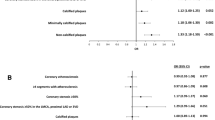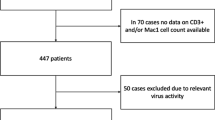Abstract
Myocardial ischemia provoked in the laboratory during mental stress (MSI) in patients with stable coronary artery disease (CAD) predicts subsequent clinical events. The pathophysiology of MSI differs from that of exercise ischemia, and the mechanisms tying MSI to poor prognosis are not known. C-reactive protein (CRP) is a risk marker for cardiovascular events in patients with CAD, but little is known regarding the relationship of CRP to MSI. The purpose of this study was to examine the association of CRP to risk of MSI in CAD patients. Eighty-three patients with stable CAD underwent simultaneous single-photon emission computed tomography (SPECT) imaging with technetium-99m tetrofosmin myocardial perfusion imaging (MPI) and transthoracic echocardiography (TTE), at rest and during MS induced by laboratory mental stress. Serum CRP levels were measured 24 h after MS. MSI was defined by the presence of a new perfusion defect on SPECT and/or new regional wall motion abnormality on TTE during MS. Of the 83 patients, 30 (36%) developed MSI. There was no difference in gender, sex, BMI, histories of diabetes, hypertension, smoking, lipid profile, medications used (including statins, β-blockers, ACE inhibitors, and aspirin), or hemodynamic response during MS between those with and without MSI. In univariate logistic regression analysis, each unit (1 mg/L) increase in CRP level was associated with 20% higher risk of MSI (OR 1.2, 95% CI 1.01–1.39, P =.04). This relationship remained in multivariate models. These data suggest that levels of CRP may be a risk marker for MSI in patients with CAD.

Similar content being viewed by others
References
Everson SA, Lynch JW, Chesney MA, et al. (1997) Interaction of workplace demands and cardiovascular reactivity in progression of carotid atherosclerosis: population based study. BMJ 314:553–8.
Hemingway H, Shipley M, Macfarlane P, Marmot M. (2000) Impact of socioeconomic status on coronary mortality in people with symptoms, electrocardiographic abnormalities, both or neither: the original Whitehall study 25 year follow up. J. Epidemiol. Comm. Health 54:510–6.
Whiteman MC, Deary IJ, Fowkes FG. (2000) Personality and social predictors of atherosclerotic progression: Edinburgh Artery Study. Psychosom. Med. 62:703–14.
Leor J, Poole WK, Kloner RA. (1996) Sudden cardiac death triggered by an earthquake. N. Engl. J. Med. 334:413–9.
Meisel SR, Kutz I, Dayan KI, et al. (1991) Effect of Iraqi missile war on incidence of acute myocardial infarction and sudden death in Israeli civilians [see comment]. Lancet 338:660–1.
Krantz DS, Sheps DS, Carney RM, Natelson BH. (2000) Effects of mental stress in patients with coronary artery disease: evidence and clinical implications. JAMA 283:1800–2.
Mittleman MA, Maclure M, Sherwood JB, et al. (1995) Triggering of acute myocardial infarction onset by episodes of anger. Determinants of Myocardial Infarction Onset Study Investigators [see comment]. Circulation 92:1720–5.
Servoss SJ, Januzzi JL, Muller JE. (2002) Triggers of acute coronary syndromes. Prog. Cardiovas. Dis. 44:369–80.
Williams JE, Nieto FJ, Sanford CP, Tyroler HA. (2001) Effects of an angry temperament on coronary heart disease risk: The Atherosclerosis Risk in Communities Study. Am. J. Epidemiol. 154:230–5.
Wittstein IS, Thiemann DR, Lima JAC, et al. (2005) Neurohumoral features of myocardial stunning due to sudden emotional stress [see comment]. N. Engl. J. Med. 352: 539–48.
Burg MM, Jain D, Soufer R, Kerns RD, Zaret BL. (1993) Role of behavioral and psychological factors in mental stress-induced silent left ventricular dysfunction in coronary artery disease. J. Am. Coll. Cardiol. 22:440–8.
Rozanski A, Bairey CN, Krantz DS, et al. (1988) Mental stress and the induction of silent myocardial ischemia in patients with coronary artery disease. N. Engl. J. Med. 318:1005–12.
Jain D, Burg M, Soufer R, Zaret BL. (1995) Prognostic implications of mental stress-induced silent left ventricular dysfunction in patients with stable angina pectoris [see comment]. Am. J. Cardiol. 76:31–5.
Jiang W, Babyak M, Krantz DS, et al. (1996) Mental stress-induced myocardial ischemia and cardiac events. JAMA 275:1651–6.
Krantz DS, Santiago HT, Kop WJ, Bairey Merz CN, Rozanski A, Gottdiener JS. (1999) Prognostic value of mental stress testing in coronary artery disease. Am. J. Cardiol. 84:1292–7.
Sheps DS, McMahon RP, Becker L, et al. (2002) Mental stress-induced ischemia and all-cause mortality in patients with coronary artery disease: Results from the Psychophysiological Investigations of Myocardial Ischemia study [see comment]. Circulation 105:1780–4.
US Department of Health and Human Services. National Heart, Lung, and Blood Institute Report of the Task Force on Behavioral Research in Cardiovascular, Lung, and Blood Health and Disease; 1998. Available at: https://doi.org/www.nhlbi.nih.gov/resources/docs/taskforc.htm. Accessed March 27, 2006.
Soufer R. (2004) Neurocardiac interaction during stress-induced myocardial ischemia: how does the brain cope? Circulation 110:1710–3.
Burg MM, Vashist A, Soufer R. (2005) Mental stress ischemia: present status and future goals. J. Nucl. Cardiol. 12:523–9.
Bacon SL, Watkins LL, Babyak M, et al. (2004) Effects of daily stress on autonomic cardiac control in patients with coronary artery disease. Am. J. Cardiol. 93:1292–4.
Grossman P, Watkins LL, Wilhelm FH, Manolakis D, Lown B. (1996) Cardiac vagal control and dynamic responses to psychological stress among patients with coronary artery disease. Am. J. Cardiol. 78:1424–7.
Hughes JW, Stoney CM. (2000) Depressed mood is related to high-frequency heart rate variability during stressors. Psychosom. Med. 62:796–803.
Lucini D, Di Fede G, Parati G, Pagani M. (2005) Impact of chronic psychosocial stress on autonomic cardiovascular regulation in otherwise healthy subjects. Hypertension 46:1201–6.
Sloan RP, Huang M-H, Sidney S, Liu K, Williams OD, Seeman T. (2005) Socioeconomic status and health: is parasympathetic nervous system activity an intervening mechanism? Int. J. Epidemiol. 34:309–15.
Hasko G, Szabo C. (1998) Regulation of cytokine and chemokine production by transmitters and co-transmitters of the autonomic nervous system. Biochem. Pharmacol. 56:1079–87.
Papanicolaou DA, Petrides JS, Tsigos C, et al. (1996) Exercise stimulates interleukin-6 secretion: inhibition by glucocorticoids and correlation with catecholamines. Am. J. Physiol. 271:E601–5.
Pavlov VA, Tracey KJ. (2004) Neural regulators of innate immune responses and inflammation. Cell. Mol. Life Sci. 61:2322–31.
Takaki A, Huang QH, Somogyvari-Vigh A, Arimura A. (1994) Immobilization stress may increase plasma interleukin-6 via central and peripheral catecholamines. Neuroimmunomodulation 1:335–42.
Andersson J. (2005) The inflammatory reflex-introduction. J. Intern. Med. 257:122–5.
Tracey KJ. (2002) The inflammatory reflex. Nature 420:853–9.
Bernik TR, Friedman SG, Ochani M, et al. (2002) Pharmacological stimulation of the cholinergic anti-inflammatory pathway [see comment]. J. Exp. Med. 195:781–8.
Borovikova LV, Ivanova S, Zhang M, et al. (2000) Vagus nerve stimulation attenuates the systemic inflammatory response to endotoxin. Nature 405: 458–62.
Ridker PM. (2003) Clinical application of C-reactive protein for cardiovascular disease detection and prevention [see comment]. Circulation 107:363–9.
Liu Y-H, Sinusas AJ, Shi CQX, et al. (1996) Quantification of technetium 99m-labeled sestamibi single-photon emission computed tomography based on mean counts improves accuracy for assessment of relative regional myocardial blood flow: Experimental validation in a canine model. J. Nucl. Cardiol. 3:312–20.
Soufer R, Bremner JD, Arrighi JA, et al. (1998) Cerebral cortical hyperactivation in response to mental stress in patients with coronary artery disease. Proc. Natl. Acad. Sci. USA. 95:6454–9.
LaVeau PJ, Rozanski A, Krantz DS, et al. (1989) Transient left ventricular dysfunction during provocative mental stress in patients with coronary artery disease. Am. Heart J. 118:1–8.
Beattie MS, Shlipak MG, Liu H, Browner WS, Schiller NB, Whooley MA. (2003) C-reactive protein and ischemia in users and nonusers of beta-blockers and statins: data from the Heart and Soul Study. Circulation 107:245–50.
Liuzzo G, Biasucci LM, Rebuzzi AG, et al. (1996) Plasma protein acute-phase response in unstable angina is not induced by ischemic injury. Circulation 94:2373–80.
Steptoe A, Willemsen G, Owen N, Flower L, Mohamed-Ali V. (2001) Acute mental stress elicits delayed increases in circulating inflammatory cytokine levels [see comment]. Clin. Sci. 101:185–92.
Buffon A, Biasucci LM, Liuzzo G, D’Onofrio G, Crea F, Maseri A. (2002) Widespread coronary inflammation in unstable angina [see comment]. N. Engl. J. Med. 347:5–12.
Libby P. (2002) Inflammation in atherosclerosis. Nature 420:868–74.
Paoletti R, Gotto AM, Jr., Hajjar DP. (2004) Inflammation in atherosclerosis and implications for therapy. Circulation 109:III20–6.
Tiong AY, Brieger D. (2005) Inflammation and coronary artery disease. Am. Heart J. 150:11–8.
Pearson TA, Mensah GA, Alexander RW, et al. (2003) Markers of inflammation and cardiovascular disease: application to clinical and public health practice: A statement for healthcare professionals from the Centers for Disease Control and Prevention and the American Heart Association [see comment]. Circulation 107:499–511.
Roberts WL, Moulton L, Law TC, et al. (2001) Evaluation of nine automated high-sensitivity C-reactive protein methods: implications for clinical and epidemiological applications. Part 2 [see comment][erratum appears in Clin. Chem. 2001 May;47(5):980]. Clin. Chem. 47:418–25.
Bisoendial RJ, Kastelein JJP, Levels JHM, et al. (2005) Activation of inflammation and coagulation after infusion of C-reactive protein in humans [see comment]. Circ. Res. 96:714–6.
Schwedler SB, Amann K, Wernicke K, et al. (2005) Native C-reactive protein increases whereas modified C-reactive protein reduces atherosclerosis in apolipoprotein E-knockout mice. Circulation 112:1016–23.
Kiecolt-Glaser JK, Preacher KJ, MacCallum RC, Atkinson C, Malarkey WB, Glaser R. (2003) Chronic stress and age-related increases in the proinflammatory cytokine IL-6. Proc. Natl. Acad. Sci. USA. 100:9090–5.
Zhou D, Kusnecov AW, Shurin MR, DePaoli M, Rabin BS. (1993) Exposure to physical and psychological stressors elevates plasma interleukin 6: relationship to the activation of hypothalamicpituitary-adrenal axis. Endocrinology 133:2523–30.
Maes M, Song C, Lin A, et al. (1998) The effects of psychological stress on humans: increased production of pro-inflammatory cytokines and a Th1-like response in stress-induced anxiety. Cytokine 10:313–8.
Tofler GH. (1997) Triggering and the pathophysiology of acute coronary syndromes. Am. Heart J. 134:S55–61.
Frasure-Smith N, Lesperance F, Talajic M. (1993) Depression following myocardial infarction. Impact on 6-month survival. JAMA 270:1819–25.
Frasure-Smith N, Lesperance F, Talajic M. (1995) Depression and 18-month prognosis after myocardial infarction. Circulation 91:999–1005.
Berk M, Wadee AA, Kuschke RH, O’Neill-Kerr A. (1997) Acute phase proteins in major depression. J. Psychosom. Res. 43:529–34.
Sluzewska A, Rybakowski J, Bosmans E, et al. (1996) Indicators of immune activation in major depression. Psychiatry Res. 64:161–7.
Obrein S, Scott L, Dinan T. (2006) Antidepressant therapy and C-reactive protein levels Bri. J. Psychi. 188:449–52.
Nathan C. (2002) Points of control in inflammation. Nature 420:846–52.
Hamer M, Williams E, Vuonovirta R, Giacobazzi P, Gibson EL, Steptoe A. (2006) The effects of effort-reward imbalance on inflammatory and cardiovascular responses to mental stress. Psychosom. Med. 68:408–13.
Acknowledgments
We thank Dr. William C. Sessa, Professor of Pharmacology, Yale University School of Medicine, for his contribution to the conceptual construct.
This work was supported by R01 awards (HL59619-01 and HL071116-01) from the National Heart, Lung, and Blood Institute, and by a Merit Review award from the Department of Veterans Affairs to Dr. Soufer.
Author information
Authors and Affiliations
Corresponding author
Rights and permissions
About this article
Cite this article
Shah, R., Burg, M.M., Vashist, A. et al. C-Reactive Protein and Vulnerability to Mental Stress-Induced Myocardial Ischemia. Mol Med 12, 269–274 (2006). https://doi.org/10.2119/2006-00077.Shah
Received:
Accepted:
Published:
Issue Date:
DOI: https://doi.org/10.2119/2006-00077.Shah




